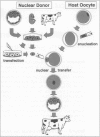Abstract
Animal cloning is becoming a useful technique for producing transgenic farm animals and is likely to be used to produce clones from valuable adults. Other applications will also undoubtedly be discovered in the near future, such as for preserving endangered breeds and species. Although cloning promises great advantages for commerce and research alike, its outcome is not always certain due to high pregnancy losses and high morbidity and mortality during the neonatal period. Research into the mechanisms involved in the reprogramming of the nucleus is being conducted throughout the world in an attempt to better understand the molecular and cellular mechanisms involved in correcting these problems. Although the cause of these anomalies remains mostly unknown, similar phenotypes have been observed in calves derived through in vitro fertilization, suggesting that culture conditions are involved in these phenomena. In the meantime, veterinarians and theriogenologists have an important role to play in improving the efficiency of cloning by finding treatments to assure normal gestation to term and to develop preventative and curative care for cloned neonates.
Full text
PDF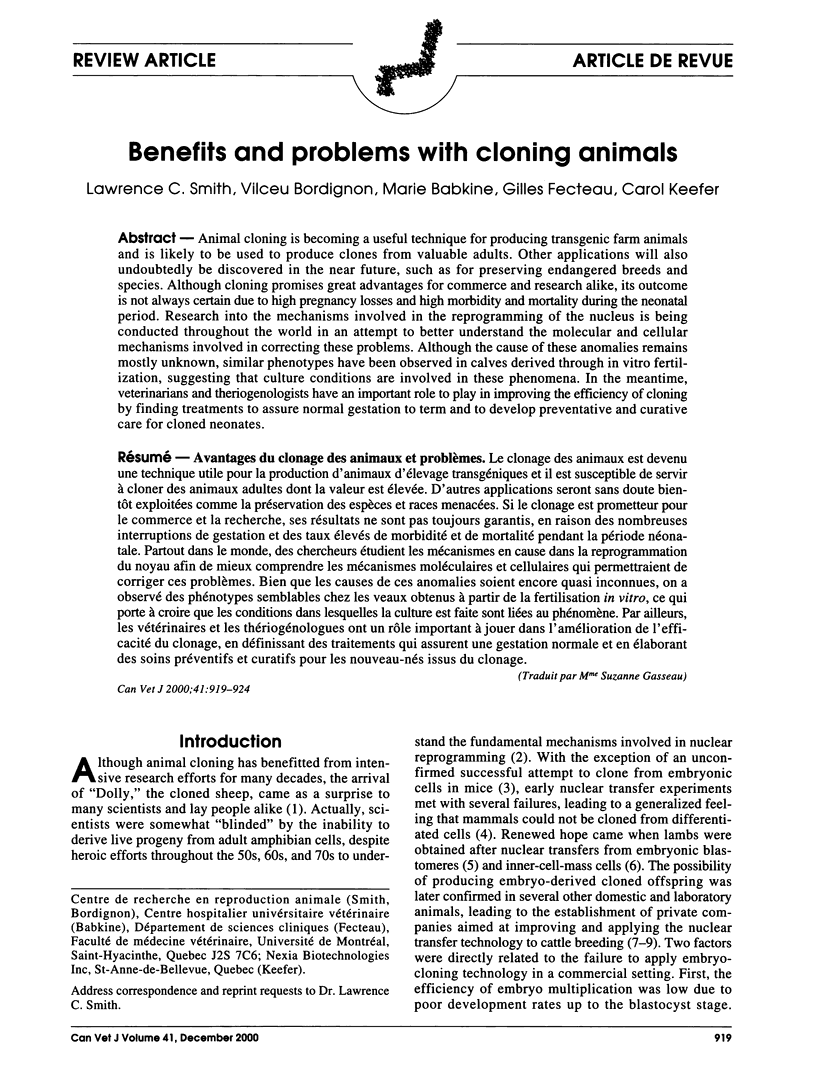
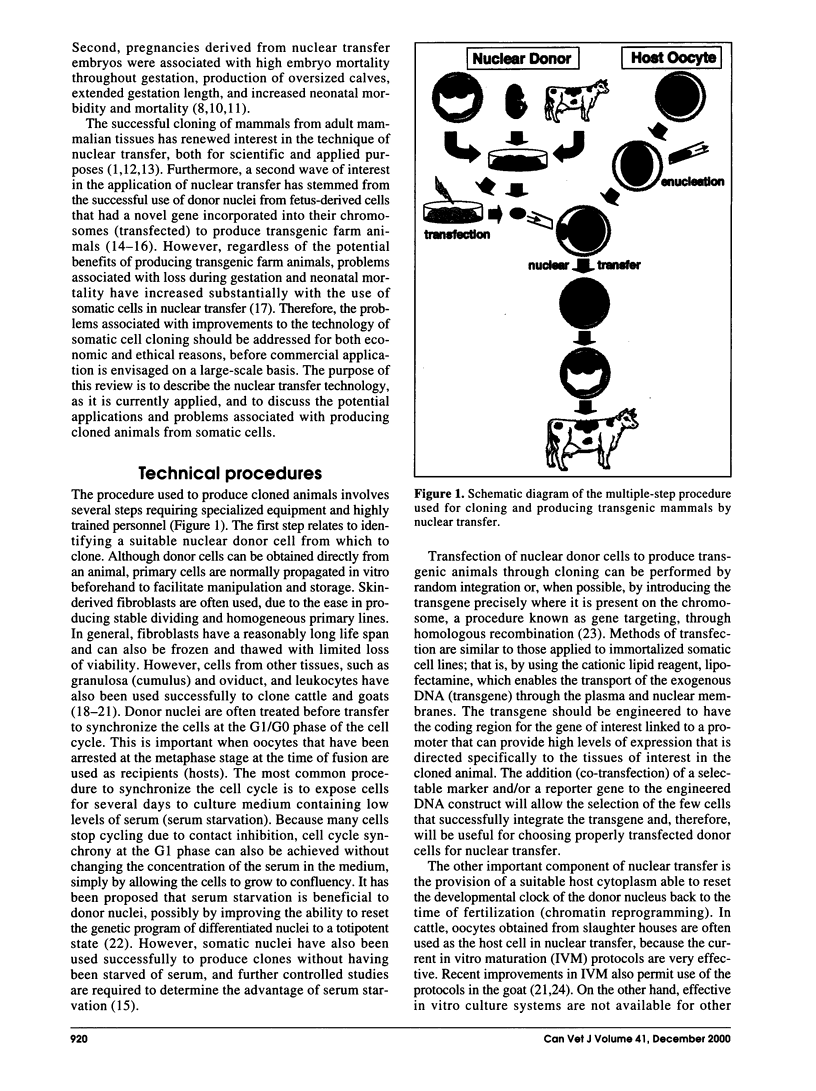
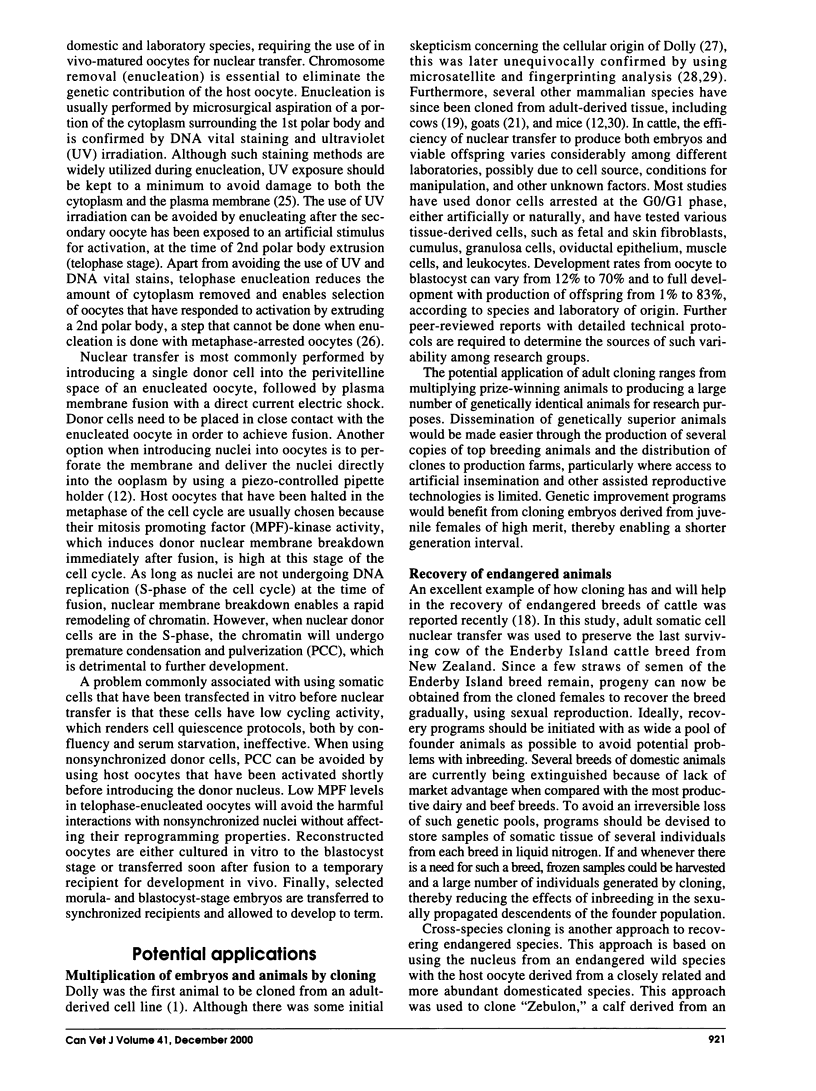
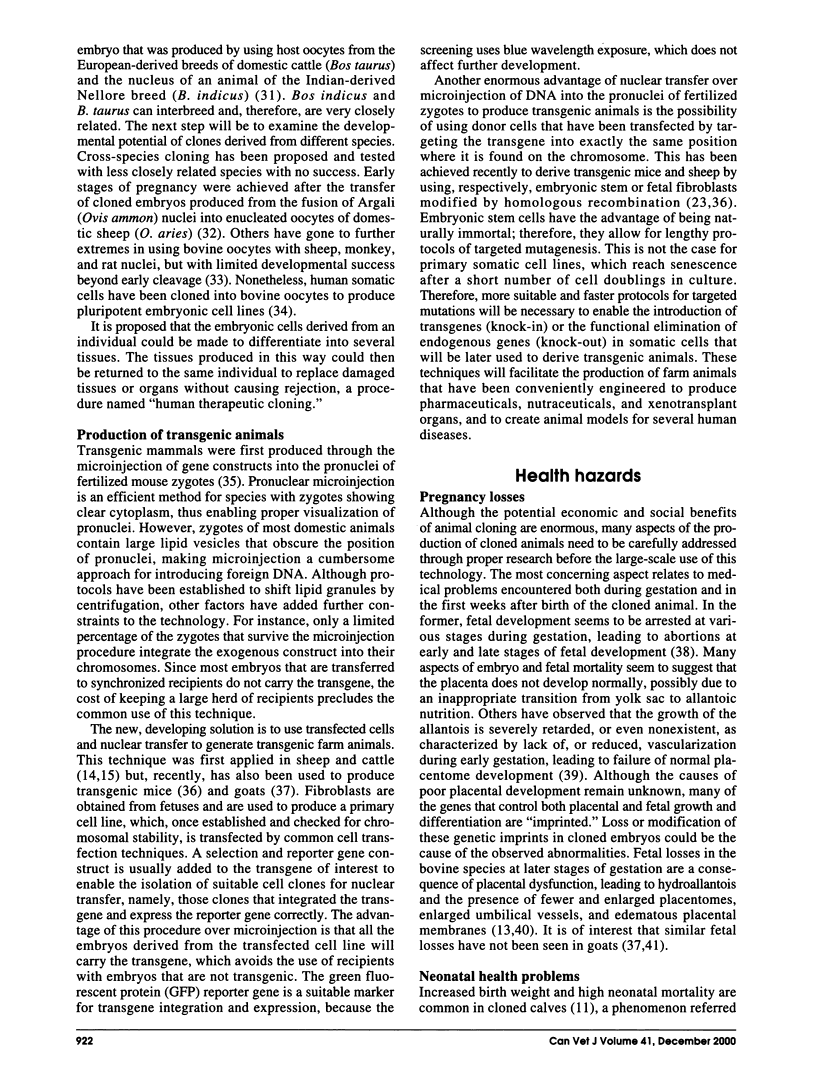
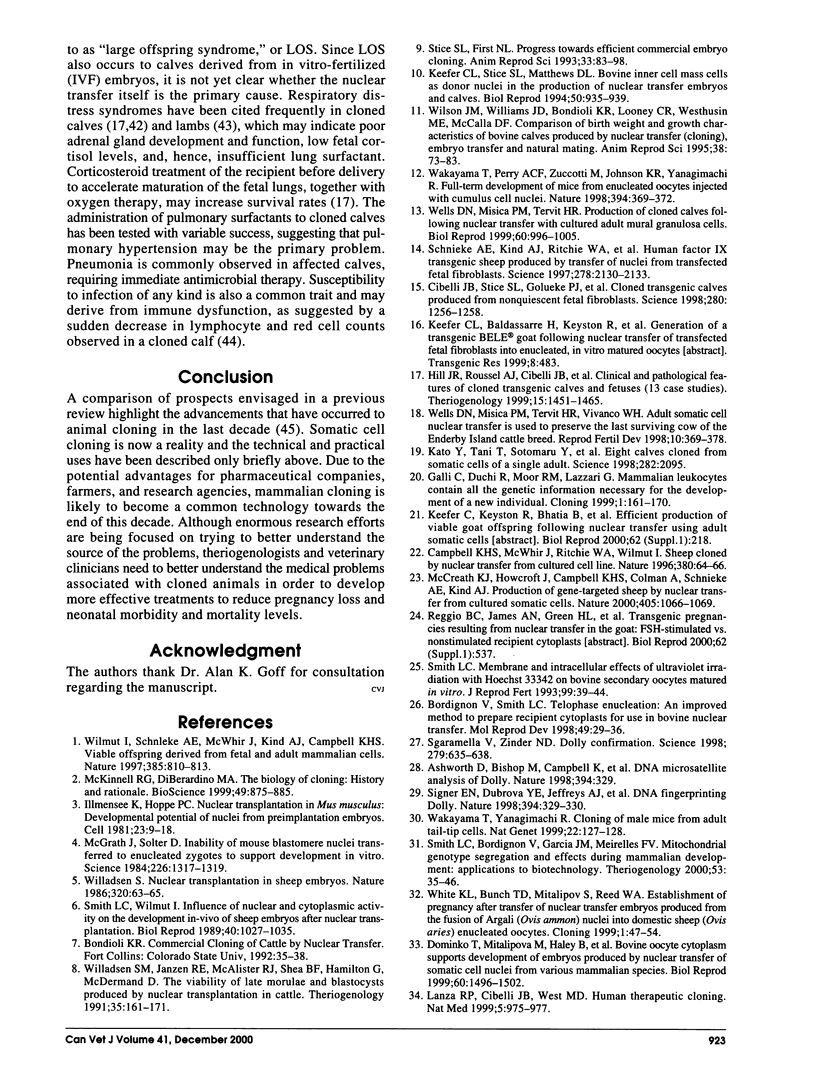
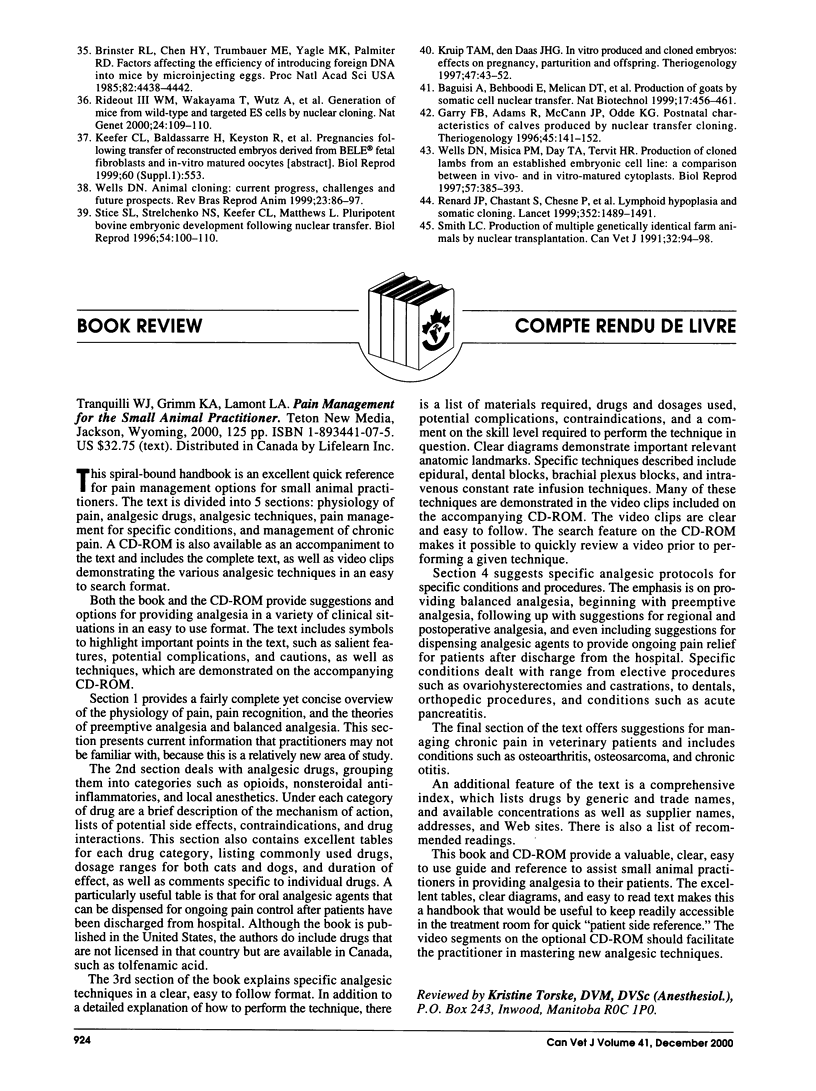
Images in this article
Selected References
These references are in PubMed. This may not be the complete list of references from this article.
- Ashworth D., Bishop M., Campbell K., Colman A., Kind A., Schnieke A., Blott S., Griffin H., Haley C., McWhir J. DNA microsatellite analysis of Dolly. Nature. 1998 Jul 23;394(6691):329–329. doi: 10.1038/28521. [DOI] [PubMed] [Google Scholar]
- Baguisi A., Behboodi E., Melican D. T., Pollock J. S., Destrempes M. M., Cammuso C., Williams J. L., Nims S. D., Porter C. A., Midura P. Production of goats by somatic cell nuclear transfer. Nat Biotechnol. 1999 May;17(5):456–461. doi: 10.1038/8632. [DOI] [PubMed] [Google Scholar]
- Bordignon V., Smith L. C. Telophase enucleation: an improved method to prepare recipient cytoplasts for use in bovine nuclear transfer. Mol Reprod Dev. 1998 Jan;49(1):29–36. doi: 10.1002/(SICI)1098-2795(199801)49:1<29::AID-MRD4>3.0.CO;2-Q. [DOI] [PubMed] [Google Scholar]
- Brinster R. L., Chen H. Y., Trumbauer M. E., Yagle M. K., Palmiter R. D. Factors affecting the efficiency of introducing foreign DNA into mice by microinjecting eggs. Proc Natl Acad Sci U S A. 1985 Jul;82(13):4438–4442. doi: 10.1073/pnas.82.13.4438. [DOI] [PMC free article] [PubMed] [Google Scholar]
- Campbell K. H., McWhir J., Ritchie W. A., Wilmut I. Sheep cloned by nuclear transfer from a cultured cell line. Nature. 1996 Mar 7;380(6569):64–66. doi: 10.1038/380064a0. [DOI] [PubMed] [Google Scholar]
- Cibelli J. B., Stice S. L., Golueke P. J., Kane J. J., Jerry J., Blackwell C., Ponce de León F. A., Robl J. M. Cloned transgenic calves produced from nonquiescent fetal fibroblasts. Science. 1998 May 22;280(5367):1256–1258. doi: 10.1126/science.280.5367.1256. [DOI] [PubMed] [Google Scholar]
- Dominko T., Mitalipova M., Haley B., Beyhan Z., Memili E., McKusick B., First N. L. Bovine oocyte cytoplasm supports development of embryos produced by nuclear transfer of somatic cell nuclei from various mammalian species. Biol Reprod. 1999 Jun;60(6):1496–1502. doi: 10.1095/biolreprod60.6.1496. [DOI] [PubMed] [Google Scholar]
- Galli C., Duchi R., Moor R. M., Lazzari G. Mammalian leukocytes contain all the genetic information necessary for the development of a new individual. Cloning. 1999;1(3):161–170. doi: 10.1089/15204559950019924. [DOI] [PubMed] [Google Scholar]
- Hill J. R., Roussel A. J., Cibelli J. B., Edwards J. F., Hooper N. L., Miller M. W., Thompson J. A., Looney C. R., Westhusin M. E., Robl J. M. Clinical and pathologic features of cloned transgenic calves and fetuses (13 case studies). Theriogenology. 1999 Jun;51(8):1451–1465. doi: 10.1016/s0093-691x(99)00089-8. [DOI] [PubMed] [Google Scholar]
- Kato Y., Tani T., Sotomaru Y., Kurokawa K., Kato J., Doguchi H., Yasue H., Tsunoda Y. Eight calves cloned from somatic cells of a single adult. Science. 1998 Dec 11;282(5396):2095–2098. doi: 10.1126/science.282.5396.2095. [DOI] [PubMed] [Google Scholar]
- Keefer C. L., Stice S. L., Matthews D. L. Bovine inner cell mass cells as donor nuclei in the production of nuclear transfer embryos and calves. Biol Reprod. 1994 Apr;50(4):935–939. doi: 10.1095/biolreprod50.4.935. [DOI] [PubMed] [Google Scholar]
- Lanza R. P., Cibelli J. B., West M. D. Human therapeutic cloning. Nat Med. 1999 Sep;5(9):975–977. doi: 10.1038/12404. [DOI] [PubMed] [Google Scholar]
- McCreath K. J., Howcroft J., Campbell K. H., Colman A., Schnieke A. E., Kind A. J. Production of gene-targeted sheep by nuclear transfer from cultured somatic cells. Nature. 2000 Jun 29;405(6790):1066–1069. doi: 10.1038/35016604. [DOI] [PubMed] [Google Scholar]
- McGrath J., Solter D. Inability of mouse blastomere nuclei transferred to enucleated zygotes to support development in vitro. Science. 1984 Dec 14;226(4680):1317–1319. doi: 10.1126/science.6542249. [DOI] [PubMed] [Google Scholar]
- Renard J. P., Chastant S., Chesné P., Richard C., Marchal J., Cordonnier N., Chavatte P., Vignon X. Lymphoid hypoplasia and somatic cloning. Lancet. 1999 May 1;353(9163):1489–1491. doi: 10.1016/S0140-6736(98)12173-6. [DOI] [PubMed] [Google Scholar]
- Rideout W. M., 3rd, Wakayama T., Wutz A., Eggan K., Jackson-Grusby L., Dausman J., Yanagimachi R., Jaenisch R. Generation of mice from wild-type and targeted ES cells by nuclear cloning. Nat Genet. 2000 Feb;24(2):109–110. doi: 10.1038/72753. [DOI] [PubMed] [Google Scholar]
- Schnieke A. E., Kind A. J., Ritchie W. A., Mycock K., Scott A. R., Ritchie M., Wilmut I., Colman A., Campbell K. H. Human factor IX transgenic sheep produced by transfer of nuclei from transfected fetal fibroblasts. Science. 1997 Dec 19;278(5346):2130–2133. doi: 10.1126/science.278.5346.2130. [DOI] [PubMed] [Google Scholar]
- Sgaramella V., Zinder N. D. Dolly confirmation. Science. 1998 Jan 30;279(5351):635, 637-8. doi: 10.1126/science.279.5351.635c. [DOI] [PubMed] [Google Scholar]
- Signer E. N., Dubrova Y. E., Jeffreys A. J., Wilde C., Finch L. M., Wells M., Peaker M. DNA fingerprinting Dolly. Nature. 1998 Jul 23;394(6691):329–330. doi: 10.1038/28524. [DOI] [PubMed] [Google Scholar]
- Smith L. C., Bordignon V., Garcia J. M., Meirelles F. V. Mitochondrial genotype segregation and effects during mammalian development: applications to biotechnology. Theriogenology. 2000 Jan 1;53(1):35–46. doi: 10.1016/s0093-691x(99)00238-1. [DOI] [PubMed] [Google Scholar]
- Smith L. C. Membrane and intracellular effects of ultraviolet irradiation with Hoechst 33342 on bovine secondary oocytes matured in vitro. J Reprod Fertil. 1993 Sep;99(1):39–44. doi: 10.1530/jrf.0.0990039. [DOI] [PubMed] [Google Scholar]
- Smith L. C. Production of multiple genetically identical farm animals by nuclear transplantation. Can Vet J. 1991 Feb;32(2):94–98. [PMC free article] [PubMed] [Google Scholar]
- Smith L. C., Wilmut I. Influence of nuclear and cytoplasmic activity on the development in vivo of sheep embryos after nuclear transplantation. Biol Reprod. 1989 May;40(5):1027–1035. doi: 10.1095/biolreprod40.5.1027. [DOI] [PubMed] [Google Scholar]
- Stice S. L., Strelchenko N. S., Keefer C. L., Matthews L. Pluripotent bovine embryonic cell lines direct embryonic development following nuclear transfer. Biol Reprod. 1996 Jan;54(1):100–110. doi: 10.1095/biolreprod54.1.100. [DOI] [PubMed] [Google Scholar]
- Wakayama T., Perry A. C., Zuccotti M., Johnson K. R., Yanagimachi R. Full-term development of mice from enucleated oocytes injected with cumulus cell nuclei. Nature. 1998 Jul 23;394(6691):369–374. doi: 10.1038/28615. [DOI] [PubMed] [Google Scholar]
- Wakayama T., Yanagimachi R. Cloning of male mice from adult tail-tip cells. Nat Genet. 1999 Jun;22(2):127–128. doi: 10.1038/9632. [DOI] [PubMed] [Google Scholar]
- Wells D. N., Misica P. M., Day T. A., Tervit H. R. Production of cloned lambs from an established embryonic cell line: a comparison between in vivo- and in vitro-matured cytoplasts. Biol Reprod. 1997 Aug;57(2):385–393. doi: 10.1095/biolreprod57.2.385. [DOI] [PubMed] [Google Scholar]
- Wells D. N., Misica P. M., Tervit H. R. Production of cloned calves following nuclear transfer with cultured adult mural granulosa cells. Biol Reprod. 1999 Apr;60(4):996–1005. doi: 10.1095/biolreprod60.4.996. [DOI] [PubMed] [Google Scholar]
- Wells D. N., Misica P. M., Tervit H. R., Vivanco W. H. Adult somatic cell nuclear transfer is used to preserve the last surviving cow of the Enderby Island cattle breed. Reprod Fertil Dev. 1998;10(4):369–378. doi: 10.1071/r98109. [DOI] [PubMed] [Google Scholar]
- White K. L., Bunch T. D., Mitalipov S., Reed W. A. Establishment of pregnancy after the transfer of nuclear transfer embryos produced from the fusion of argali (Ovis ammon) nuclei into domestic sheep (Ovis aries) enucleated oocytes. Cloning. 1999;1(1):47–54. doi: 10.1089/15204559950020085. [DOI] [PubMed] [Google Scholar]
- Willadsen S. M. Nuclear transplantation in sheep embryos. Nature. 1986 Mar 6;320(6057):63–65. doi: 10.1038/320063a0. [DOI] [PubMed] [Google Scholar]
- Wilmut I., Schnieke A. E., McWhir J., Kind A. J., Campbell K. H. Viable offspring derived from fetal and adult mammalian cells. Nature. 1997 Feb 27;385(6619):810–813. doi: 10.1038/385810a0. [DOI] [PubMed] [Google Scholar]



